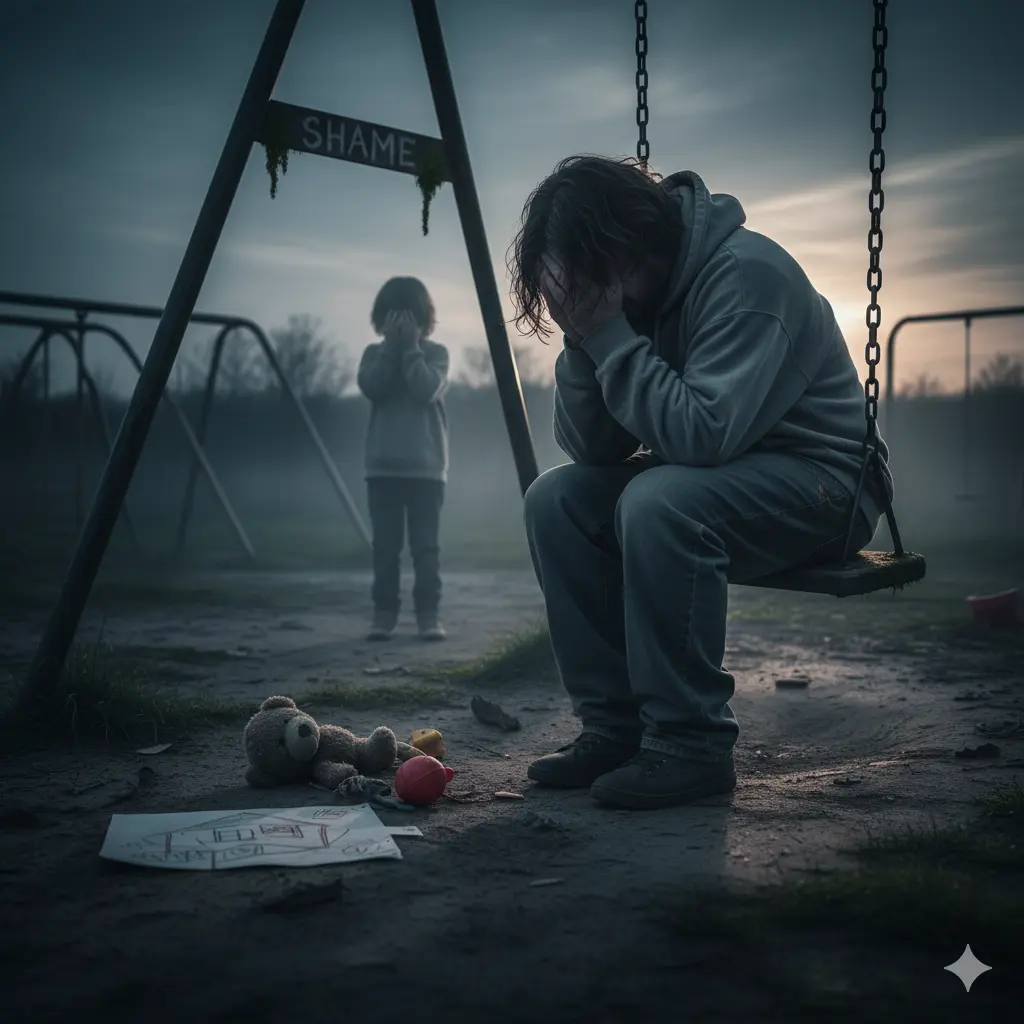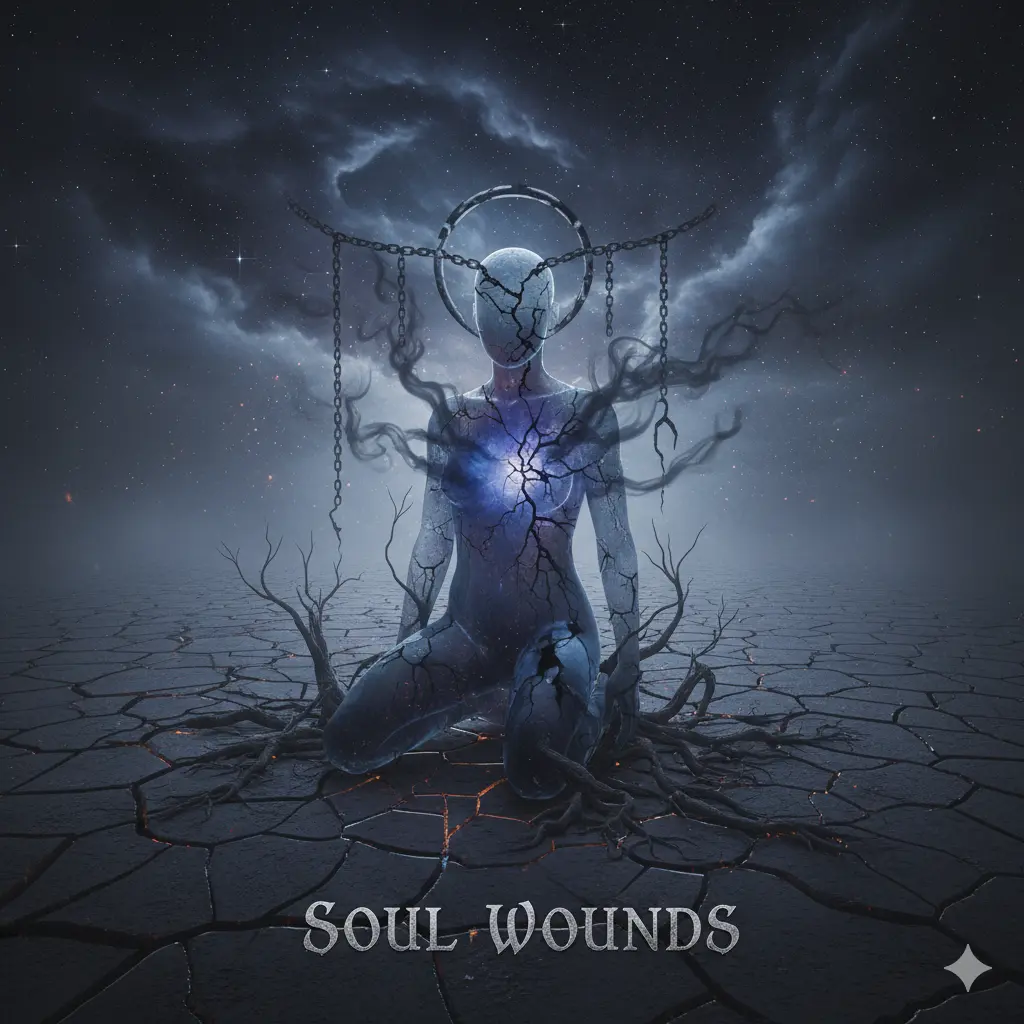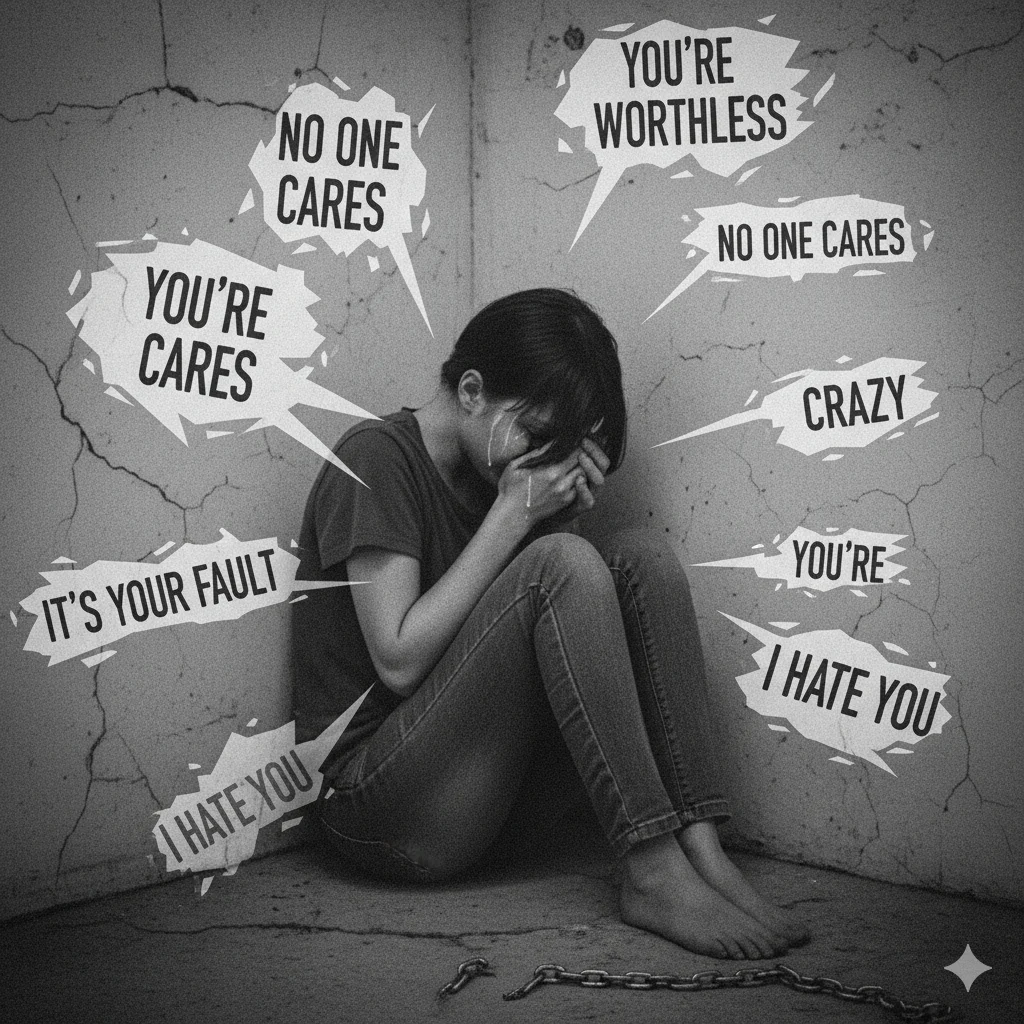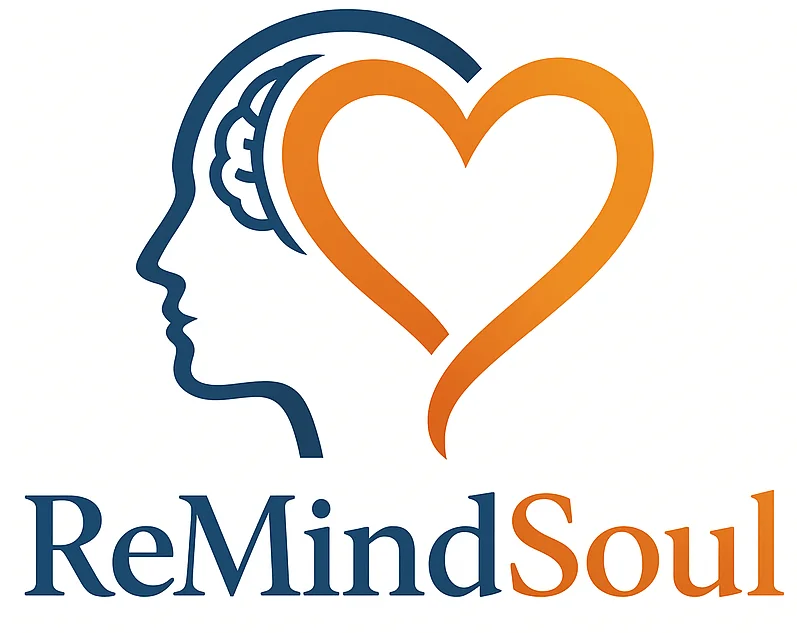Emotional Wounds
😣😳🩹
Discover how to heal emotional wounds with compassionate guidance. Learn the causes, signs, and steps to release shame, pain and emotions and rebuild self-worth.
Emotional Wounds: A Complete Guide to Understanding and Healing
This guide provides you with compassionate tools to understand and heal the pain of shame, toxic beliefs, and deep emotional wounds. You’ll discover practical exercises, meditations, and self-compassion practices that help you release the false belief that you are fundamentally flawed and reconnect with your inherent worth.

Healing Shame
Shame Definition in Psychology
Shame is a painful emotion that makes you feel like there’s something fundamentally wrong with who you are as a person. It’s not just feeling bad about what you did, but feeling bad about who you are. It quietly shapes how you see yourself, how you connect with others, and how you handle life’s challenges.
Shame lives in the shadows of your past, whispering that you are fundamentally flawed.
Unlike guilt, which says “I did something bad,” shame tells you “I am bad.”
This belief limits your capacity for connection and joy. Over time, the message becomes clear: “I am not worthy of love or belonging.”

Shame in Public Meaning
Shame in public happens when your private insecurities are exposed for others to witness. It is the sense of being uncovered and unprotected in your humanity. The inner voice says, “I am not safe being myself.”
Common triggers include:
- Public criticism or failure
- Being laughed at or rejected
- Making a visible mistake
- Feeling others’ eyes on your imperfections
Shame in public makes you want to hide or disappear, but healing begins with gentle self-acceptance. Remind yourself:
- “Everyone makes mistakes.”
- “Being seen does not make me unworthy.”
- “I can stand in my truth without shame.”
Walk of Shame Meaning
The walk of shame is the feeling of embarrassment that comes after doing something you regret or fear others will judge you for. It is not just a physical walk; it is the emotional weight of being seen when you want to hide. Beneath the humor often linked to the phrase lies a deeper message: “Everyone can see my mistake.”
The walk of shame reflects:
- The fear of judgment or rejection
- The discomfort of visibility after vulnerability
- The belief that others are defining your worth
It is not the act itself that causes pain, but the meaning you attach to being seen. Healing comes when you remember that one moment does not define who you are.
Healing Shame Wounds
Shame wounds form when you internalize the belief that something about you is wrong or unworthy. They often begin in moments of criticism, rejection, neglect, or trauma. When left unhealed, they shape your confidence, boundaries, and ability to trust others.
Common signs of shame wounds include:
- A harsh inner critic that constantly finds fault
- The urge to hide parts of yourself from others
- A deep fear of being seen or rejected
- Feeling undeserving of love or happiness
- Avoiding vulnerability to protect yourself from judgment
Create a shame inventory by listing moments when you felt exposed or inadequate. You don’t need to relive them—just acknowledge them.
When you notice thoughts like “I’m not good enough” or “I don’t deserve love,” remind yourself that these are echoes of old pain, not truth.
Replace them with compassionate truths such as:
- “I am growing and learning.”
- “My mistakes do not define my worth.”
- “I am worthy of love as I am.”
Reconnect with your body. Shame often lives physically:
- Tightness in your chest
- A heavy stomach
- Lowered posture
- Clenched muscles
Gentle self-touch, deep breathing and heart-opening movements help restore safety and connection to your body.
Healing from Guilt and Shame
Understanding the difference between guilt and shame brings clarity.
- Guilt says, “I did something wrong.”
- Shame says, “I am doing something wrong.”
Guilt can be healthy when it motivates repair and growth. Shame, however, attacks your core identity and keeps you stuck in self-blame.
If you feel guilty, ask: “Is this guilt healthy or toxic?”
- Healthy guilt encourages reflection and amends.
- Toxic guilt keeps you trapped long after the lesson is learned.
To release toxic guilt:
- Write yourself a letter about what happened and what you learned.
- Read it aloud and affirm: “I forgive myself. I am allowed to grow.”
When shame arises, pause and breathe. Say to yourself:
“This is a shame. It’s here, but it’s not who I am.”
Naming emotions weakens their hold and creates space for healing
Pain and Shame Wounds Exercises
Practical exercises can help release shame and build resilience:
- The Self-Compassion Mirror: Look into your eyes and speak three affirmations of love and acceptance.
- Shame Resilience Journal: Track moments when shame appears. Note the trigger, your thoughts, and how your body felt. Over time, patterns will emerge.
- The Shame Dialogue: Write a conversation between your shame and your inner child. Let your adult self-respond with comfort and protection.
- Releasing Ritual: Write down painful memories or phrases that hold shame. Then safely burn or bury the paper as a symbolic act of release. Say, “I release what no longer serves me.”
- Grounding in the Present: When shame pulls you into old memories, feel your feet on the floor, take deep breaths, and remind yourself, “I am safe now.”
Healing Shame in Childhood
Many shame patterns begin in childhood. You may have been told you were too sensitive, too loud, or never good enough. Maybe love was conditional, earned only when you pleased others.

Your young self may have absorbed messages such as:
- “I must be perfect to be loved.”
- “My feelings are too much.”
- “Something is wrong with me.”
These beliefs were survival mechanisms, not truths. You were not responsible for the shame you absorbed as a child.
To heal, re-parent your inner child.
Speak gently to the younger version of yourself:
- “You are enough.”
- “You did your best.”
- “You are loved just as you are.”
Imagine hugging your inner child and letting them know they are finally safe.
Joy and creativity are natural antidotes to shame. When painful memories arise, meet them with compassion. You are no longer powerless. You have the awareness to heal now.
Healing the Shame That Binds You
John Bradshaw described toxic shame as shame that becomes identity. It binds you to silence, perfectionism, and self-sabotage.
- Begin by breaking the secrecy. Shame feeds on silence. Share your truth with someone safe. Even small acts of honesty begin to dissolve its power.
- Next, practice radical self-acceptance. Welcome every part of yourself, even the parts that still hurt. Acceptance does not mean approval; it means permission to exist.
- Finally, surround yourself with support. Seek people, spaces, and practices that reflect your worth. Healing shame is not about becoming perfect; it’s about remembering you were never broken.
→ Your Healing Journey: Release the lies of unworthiness, honor your emotions, and reclaim the truth.
Healing Toxic Shame
Toxic Shame Definition
Toxic shame creates a prison in your mind where you believe something is fundamentally wrong with who you are. This deep-seated belief affects every part of your life.
It quietly shapes how you see yourself, how you act, and even how you love. If you have ever felt deeply flawed or unworthy simply for being yourself, you may be carrying toxic shame.
Unlike ordinary shame or embarrassment, toxic shame becomes your identity. It whispers the lie, “I am not enough,” until you start believing it is true.

What Is Toxic Shame?
Toxic shame differs from temporary guilt or discomfort. It is the deep, ongoing sense that you are defective or unworthy as a person. You don’t just feel ashamed; you believe you are shame itself.
This kind of shame often begins in childhood when emotional needs were ignored, mocked, or punished. You might have heard messages such as:
- “You’re too sensitive.”
- “You’re not good enough.”
- “You’re a problem.”
Over time, these words become your inner voice. They show up as perfectionism, people-pleasing, or emotional numbness. Toxic shame convinces you that love must be earned and that your true self is unacceptable.
Healthy Shame vs. Toxic Shame
Healthy shame is part of being human. It helps you recognize when your behavior conflicts with your values. It says: “I made a mistake, but I can make it right.”
Healthy shame is:
- Temporary and specific
- Focused on behavior, not identity
- A guide toward growth and empathy
Toxic shame, however, attacks your core identity. It says: “I am a mistake.”
It is:
- Persistent and global
- Focused on self, not action
- A source of paralysis, fear, and self-rejection
Healthy shame connects you to your values. Toxic shame disconnects you from your worth. Recognizing this difference allows you to release the shame that does not belong to you and to reconnect with your authentic self.
Cure Toxic Shame
Healing toxic shame begins with awareness and compassion. You cannot think your way out of it, you must feel, name, and release it.
Start by noticing when your inner critic speaks. Ask yourself: Whose voice is this? Often, it is an old echo from childhood or a past relationship.
Replace judgment with kindness:
- “I am safe to be myself.”
- “I am enough as I am.”
- “I deserve understanding, not punishment.”
Seek safe connection. Healing happens in relationships where you can be seen without judgment. Talk with trusted friends, a therapist, or a support group. Every time you share your truth and are met with compassion, shame loses its power.
Challenge shame-based beliefs by asking:
- “Is it really true that I am completely defective?”
- “What evidence do I have that contradicts this?”
Over time, you begin to build a new inner voice, one rooted in truth and love.
Healing Toxic Shame Meditation
Meditation helps you reconnect with compassion and safety within yourself.
- Loving-Kindness Meditation: Sit comfortably, close your eyes, and repeat phrases like:
- “May I be free from suffering.”
- “May I accept myself as I am.”
- “May I know my inherent worth.”
- Body Scan Meditation: Bring your attention slowly through your body. Notice tightness, heaviness, or constriction. Breathe into these areas with softness. Shame often lives in your chest, throat, or stomach.
- Inner Child Meditation: Visualize yourself as a small child feeling ashamed. Approach this child with kindness and say:
- “You did nothing wrong.”
- “You are loved.”
- “You are safe with me.”
- Compassionate Awareness: When a shame memory arises, do not push it away. Say gently: “It’s okay. I see you.” Naming and witnessing your pain begins to free it.
Healing Toxic Shame Exercises
Healing requires action and self-expression. These exercises help release the weight of toxic shame:
- Journaling Practice: Write letters to your shame. Ask, “What are you trying to protect me from?” Understanding its purpose helps transform it.
- Affirmations: Create statements that replace shame’s lies. Say, “I am worthy of love and belonging,” or “My worth is not up for debate.” Repeat them daily.
- Mirror Work: Stand before a mirror, meet your own eyes, and speak gently to yourself. This may feel awkward, but it builds courage and self-acceptance.
- Creative Expression: Draw, sing, dance, or paint what your shame feels like. Creative movement helps release emotional energy that words cannot reach.
→ Your Healing Journey: Release the false belief that you are broken. Reclaim your worth, honor your emotions, and remember the truth.
Healing Emotional Pain
Emotional pain definition
Healing emotional pain is one of the most courageous journeys you can take. When your heart aches from loss, betrayal, or disappointment, it can feel as though the pain will never end—but you can heal.
Emotional pain is that deep ache in your chest when something hurts inside, even if no one else can see it. These wounds are real, and you are not weak for feeling them.

Cure Emotional Pain
You cannot erase emotional wounds instantly, but you can heal it step by step. Healing happens through awareness, expression, and compassion.
Start by allowing yourself to feel what you feel. Suppressing emotions only traps them deeper within. Give yourself permission to release:
- Cry when your heart feels heavy
- Write your thoughts in a journal
- Talk with someone you trust
- Sit in stillness and breathe through the discomfort
When you express emotions, you give them space to move through you instead of staying stuck.
Practice self-compassion. Speak to yourself as you would to a dear friend:
- “It’s okay to feel this way.”
- “I’m doing my best.”
- “Healing takes time, and that’s okay.”
Create healthy boundaries. Some emotional pain comes from remaining in toxic relationships or draining environments. Learn to say no, step back, or choose peace over chaos.
Support your healing with small, nurturing actions:
- Eat nourishing foods
- Rest when tired
- Spend time outdoors
- Move your body gently
- Surround yourself with calm and safety
Your body and mind are connected. When you care for one, you help the other heal.
Emotional Pain Bible Verses about Healing
If you seek spiritual comfort, Scripture reminds you that you are never alone in your pain.
- Psalm 147:3 — “He heals the brokenhearted and binds up their wounds.”
- Isaiah 41:10 — “Do not fear, for I am with you; do not be dismayed, for I am your God.”
- Matthew 11:28 — “Come to me, all you who are weary and burdened, and I will give you rest.”
Meditate on these verses daily. Let them soothe your spirit and remind you that divine love holds your heart through every storm.
Healing Emotional Pain Meditation
Meditation helps you calm your mind and reconnect with inner peace.
Find a quiet space, sit comfortably, and close your eyes. Take slow, deep breaths. As you breathe in, imagine healing light filling your heart. As you exhale, release sadness, guilt, or anger.
Try this gentle practice:
- Focus on your breath and notice how your body feels
- When painful thoughts arise, picture them as clouds drifting across the sky
- Acknowledge them, then let them pass
- Whisper to yourself, “I am healing. I am safe.”
Repeat affirmations such as:
- “I am worthy of peace.”
- “I release what no longer serves me.”
- “Each breath brings healing.”
Even a few minutes of daily meditation helps your brain and body learn to respond to emotional pain with compassion instead of fear.
Healing Emotional Pain Quotes
Words have the power to soothe and inspire healing. Reflect on these reminders:
- “The wound is the place where the Light enters you.” – Rumi
- “Healing takes courage, and we all have courage, even if we have to dig a little to find it.” – Tori Amos
- “You don’t have to control your thoughts. You just have to stop letting them control you.” – Dan Millman
- “There is no greater agony than bearing an untold story inside you.” – Maya Angelou
Let these words remind you that your pain can become your teacher, guiding you toward deeper understanding, growth, and peace.
How to Heal Emotional Pain
Healing emotional pain begins with acceptance. Allow yourself to feel without judgment. Forgive yourself and others, release guilt, and trust that time and awareness will do their work.
Helpful steps include:
- Practice mindfulness or prayer daily
- Journal your emotions with honesty
- Move your body through yoga, walking, or gentle stretching
- Seek therapy or support groups when needed
- Rest and recharge often
Remember, healing is not linear. Some days will feel light, others heavy—and both are part of your journey.
True healing happens when you stop resisting your emotional wounds and start listening to what they are trying to teach you. Pain often holds messages about boundaries, self-worth, or letting go.
If your pain feels overwhelming, reaching out for professional support is a sign of strength, not weakness. Therapists, counselors, or support groups can help you process emotions and rebuild your sense of safety.
Be patient with yourself. Healing unfolds in layers. Celebrate small victories—getting through a hard day, choosing kindness over criticism, or showing up for yourself when you want to hide.
→ Your Healing Journey: Feel, release, and nurture yourself through every wave of emotion.
Healing Emotional Wounds
Emotional Wounds Definition
Emotional wounds are the invisible scars left behind by painful experiences such as rejection, betrayal, neglect, or loss. These moments touch the heart so deeply that they shape how you see yourself and how you relate to others.
Unlike physical injuries, emotional wounds don’t always heal with time. Instead, they may quietly influence your thoughts, emotions, and relationships long after the event has passed.
You may carry hidden pain that affects your confidence, your trust in others, and your ability to love freely. Recognizing and healing these emotional wounds is an act of self-compassion.

Emotional Wounds Meaning
An emotional wound is a deep psychological hurt caused by distressing or traumatic experiences. It is not simply sadness—it is pain stored in your subconscious that affects how you respond to life. For example, if you were abandoned as a child, you may fear being left again, even in safe relationships.
Emotional wounds form when your basic needs for love, safety, validation, or belonging go unmet.
They leave imprints that shape beliefs such as “I’m not good enough” or “People can’t be trusted.”
These beliefs become invisible filters through which you interpret your world.
Deep Emotional Wounds
Deep emotional wounds are the hurts that reach the core of your identity. They often begin in childhood but can also arise from heartbreak, betrayal, or loss later in life. Over time, the pain becomes internalized and shapes your sense of worth.
Common signs of deep emotional wounds include:
- Persistent feelings of unworthiness or shame
- Fear of rejection or abandonment
- Difficulty trusting others
- Emotional numbness or avoidance
- Recurring relationship struggles
These wounds influence how you love, work, and see yourself. Healing them requires patience, self-awareness, and sometimes professional support. You deserve to feel whole, safe, and at peace.
Types of Emotional Wounds
Seven Core Emotional Wounds
Emotional wounds appear in many forms. Recognizing which ones you carry helps you understand your patterns and begin the process of healing.
Common types include:
Experts often identify seven primary emotional wounds that shape human behavior:
- Abandonment – The fear of being left behind or forgotten. Healing comes from learning that you can be your own safe place.
- Humiliation – The wound of being shamed, ridiculed, or made to feel small. It heals through self-acceptance and reclaiming your dignity.
- Betrayal – The heartbreak of broken trust or deception. It calls you to rebuild trust within yourself before extending it to others.
- Injustice – The pain of being treated unfairly or unseen. Healing grows from standing in your truth and honoring your own value.
- Loss – The ache that follows separation or grief. It invites you to cherish what remains and open your heart to new beginnings.
- Failure – The wound of not meeting expectations—your own or others’. It heals when you understand that mistakes are teachers, not verdicts on your worth.
- Rejection – The pain of feeling unwanted or unaccepted. It teaches you to embrace your inherent worth without needing approval.
How to Heal Deep Emotional Wounds
Healing begins when you face your pain with compassion instead of avoidance. Avoiding emotions keeps them buried; acknowledging them releases their power.
Steps toward healing include:
- Acknowledge your pain: Name what hurt you without minimizing it.
- Allow yourself to feel: Cry, write, or speak your emotions. Expression brings release.
- Practice self-compassion: Speak to yourself as you would to someone you love.
- Challenge limiting beliefs: Replace “I’m not enough” with “I am growing and worthy.”
- Forgive to free yourself: Forgiveness is not approval—it is the decision to stop carrying someone else’s pain.
- Nurture your inner child: Offer comfort to the younger version of yourself who was hurt.
→ Your Healing Journey: Recognize your wounds, honor your pain, and meet each scar with compassion.
Healing Soul Wounds
Soul Wounds Definition
Have you ever felt a pain that goes beyond physical or emotional hurt? You may be experiencing what many call a soul wound. These deep injuries touch the core of your being and affect how you see yourself, others, and God.
A soul wound often forms through betrayal, rejection, abuse, grief, or trauma that shakes your sense of worth and connection with the divine.
Unlike emotional wounds, which are easier to name, soul wounds are spiritual—they fracture your inner wholeness and identity in God.

Understanding soul wounds meaning
Soul wounds are deep spiritual injuries that affect your core identity and relationship with God. They can remain hidden for years, showing up as ongoing shame, unworthiness, or disconnection.
These wounds often begin in moments of deep pain—betrayal, rejection, loss, or abuse—and shape how you view love, safety, and trust.
Common signs of a soul wound include:
- Feeling disconnected from God or your purpose
- Persistent guilt or shame that prayer alone doesn’t lift
- Fear of abandonment or rejection
- Emotional numbness or emptiness
- A sense that something inside you is “broken” or “missing”
Types of Soul Wounds
Soul wounds can appear in different forms, depending on the pain you’ve endured. The most common include:
- Rejection Wounds – Create the belief that you are unlovable or unwanted.
- Abandonment Wounds – Stem from loss or neglect, leaving you fearful of being left behind.
- Betrayal Wounds – Occur when someone you trusted deeply hurts you, breaking your sense of safety.
- Shame Wounds – Convince you that something is wrong with who you are.
- Fear Wounds – Keep you trapped in anxiety, self-protection, or control.
- Trauma Wounds – Result from overwhelming experiences that your soul could not process at the time.
These wounds affect your ability to trust, love, and receive love from God and others. Healing begins by identifying them, naming them, and inviting God’s truth into the pain.
Soul Wounds in the Bible
The Bible is filled with examples of people who experienced deep soul wounds yet found healing in God’s presence.
- David faced betrayal by Saul and his son Absalom, crying out to God in his psalms: “The Lord is close to the brokenhearted and saves those who are crushed in spirit.” (Psalm 34:18)
- Job endured devastating loss yet clung to his faith, declaring, “Though He slay me, yet will I trust Him.”
- Joseph was betrayed by his brothers but chose forgiveness, saying, “What you meant for evil, God used for good.”
- Hannah wept in sorrow over infertility, but her honest prayers brought breakthrough.
- Even Jesus experienced rejection, betrayal, and grief—and through His wounds, we are healed.
Soul Wounds and Spiritual Oppression
Unhealed soul wounds can sometimes create vulnerabilities in your spiritual life. Pain that remains unaddressed may become an open door for bitterness, fear, or spiritual oppression.
These wounds are not demonic themselves, but unresolved hurt can invite negative influences through ongoing anger or unforgiveness.
You do not need to fear. Healing through prayer and repentance. As you allow God to enter your pain, the enemy loses power over your emotions and thoughts.
Deliverance and inner healing often work together—prayer brings spiritual freedom, and healing restores emotional and spiritual wholeness.
Healing the soul wound
Healing begins when you acknowledge your pain and invite God into it. Bring your soul and emotional wounds into the light through prayer and honest reflection.
God already knows your hurt—He only waits for your permission to begin restoring it.
Steps toward healing include:
- Acknowledge the Wound – Name the pain and allow yourself to feel it without shame.
- Invite God’s Presence – Pray, worship, and ask Him to reveal the roots of your suffering.
- Forgive – Release those who hurt you. Forgiveness is a process, not a single act.
- Seek Counsel – Professional Christian counseling or prayer ministry can help process trauma safely.
- Renew Your Mind – Meditate on Scriptures that affirm your worth and God’s love.
- Find Community – Surround yourself with people who reflect grace and support your healing journey.
As you walk this path, remember:
“You are not defined by your wounds. You are being restored by God’s healing touch.”
God’s love is the ultimate balm for your soul. His presence brings peace, His truth replaces lies, and His grace turns pain into purpose.
→ Your Healing Journey: Acknowledge your pain, invite God’s love into the broken places, and allow Him to restore your soul with His peace, purpose, and power.
Healing Repressed Emotions
Repressed Emotions Definition
Healing repressed emotions is one of the most transformative journeys toward emotional freedom and self-awareness. When you repress emotional wounds, you unconsciously push painful feelings out of your awareness. Over time, these buried emotions can surface as anxiety, depression, fatigue, or even physical pain.
Have you ever felt unexplained anger, sadness, or anxiety that seems to come from nowhere? You may be experiencing the effects of repressed emotions.
These hidden feelings silently shape how you think, react, and connect with others.

What Are Repressed Emotions
Repressed emotions are feelings that your mind hides from your awareness because they once felt too overwhelming or threatening to face.
Unlike suppression, which is a conscious choice to avoid emotions, repression happens automatically. It is your mind’s way of protecting you from emotional overload.
You might not remember when the repression started—it often begins in childhood when expressing feelings was unsafe or discouraged.
Over time, these emotions sink below the surface, influencing your behavior, energy, and relationships without you realizing it.
Common Repressed Emotions
To begin healing, it helps to identify what may be buried inside. Common repressed emotions include:
- Anger and resentment
- Grief and sadness
- Fear and insecurity
- Shame and guilt
- Abandonment and loneliness
- Helplessness and disappointment
Symptoms of Repressed Emotions
Your body and mind often reveal what your conscious mind hides. Repressed emotions don’t disappear—they transform into symptoms that demand attention. You may notice:
- Chronic muscle tension or unexplained body pain
- Anxiety, irritability, or sudden mood swings
- Emotional numbness or feeling detached from life
- Difficulty forming deep relationships
- Overreacting to minor stressors
- Persistent fatigue or low energy
- Trouble focusing or making decisions
What Healing Repressed Emotions Means
Healing repressed emotions means allowing yourself to feel what you once avoided. It is not about reliving trauma—it’s about creating inner safety so that emotions can finally move through you instead of staying trapped.
Start by observing what triggers discomfort and ask gently:
“What emotion might be underneath this?” Healing happens through awareness, acceptance, and release. When you meet your feelings with compassion instead of fear, they begin to lose their power.
Signs of Repressed Emotions
Repressed emotions often reveal themselves through subtle signs:
- Difficulty expressing feelings or needs
- Avoiding conflict to keep peace
- Saying “I’m fine” when you are not
- Feeling emotionally flat during major life events
- Sudden emotional outbursts that seem “out of nowhere”
- Intrusive thoughts or unexplained tension
These signs are not weaknesses—they are invitations to reconnect with parts of yourself that were once silenced.
Examples of Repressed Emotions
Repressed emotional wounds often begin as self-protection. Common examples include:
- A child told “Don’t cry” learns to bury sadness.
- Someone shamed for anger begins to suppress it.
- A person rejected in love hides their fear of abandonment.
Repressed Emotions Test
There is no single test for repressed emotions, but self-reflection helps uncover what’s hidden. Ask yourself:
- Do I avoid feeling strong emotions?
- Do I distract myself when I feel upset?
- Do I feel numb instead of angry or sad?
- Do I stay constantly busy to avoid thinking?
If you answer “yes” to several, it may be time to explore these emotions with care and support.
Suppressed vs. Repressed Emotions
It’s important to distinguish between suppression and repression:
- Suppressed emotions are consciously held back. You know they exist but choose not to express them, like holding back tears.
- Repressed emotions are unconscious. You genuinely don’t realize they exist because your mind has hidden them to protect you from pain.
Understanding this difference helps you approach healing with compassion instead of self-blame.
Practices for Emotional Release
- You can begin emotional healing through gentle, daily practices:
- Journaling honestly about your feelings and bodily sensations.
- Practicing mindfulness to notice emotions without judgment.
- Moving your body—dance, stretch, or walk mindfully.
- Using deep breathing to calm your nervous system.
- Allowing tears, laughter, or sound to move naturally through you.
Your body holds your emotions. As you listen and respond, you build trust with yourself again.
→ Your Healing Journey: Allow what was once buried to surface in safety. Reconnect with your feelings, listen to your body, and remember—you are safe to feel and free to heal.
Healing Resentment
Resentment Definition
Resentment can feel like carrying a heavy stone in your heart. When you hold onto hurt, disappointment, or unmet expectations, that weight grows heavier with time.
Whether resentment stems from a relationship, family conflict, or betrayal, it can quietly turn love and trust into distance and pain.
Resentment affects not only how you feel about others but also how you see yourself. It drains emotional energy and blocks peace.
The good news is that with awareness and gentle effort, your heart can release bitterness and open again to peace and understanding.

Understanding Why Resentment Takes Hold
You might wonder why some hurts fade while others linger for years. Resentment often forms when you feel wronged, dismissed, or betrayed, and your pain goes unacknowledged.
Perhaps someone broke your trust, ignored your needs, or repeatedly disappointed you.
These moments create emotional wounds that fester when unexpressed. Over time, unspoken hurt hardens into resentment. Healing begins when you allow yourself to name what happened and how it made you feel.
Healing Resentment in Marriage
When resentment takes root in marriage, it often grows from unmet expectations, repeated misunderstandings, or feeling emotionally unseen. You may begin to keep score, withdraw, or feel distant from your partner.

Signs of resentment in marriage include:
- Holding grudges or remembering every mistake
- Avoiding emotional closeness
- Feeling unheard or dismissed
- Criticizing more often than connecting
Healing resentment in marriage starts with honest communication. Share your feelings without blame.
Use “I” statements like:
- “I feel hurt when my needs are ignored.”
- “I feel unseen when I try to share.”
Listen with empathy, even when it feels uncomfortable. Forgiveness does not mean ignoring pain. It means letting go of the emotional weight that keeps you trapped.
Small steps help rebuild trust:
- Express gratitude daily
- Show affection intentionally
- Say “thank you” for simple things
If the resentment runs deep, couples therapy or guided journaling can help you reconnect. Healing in marriage is not about perfection—it’s about returning to understanding.
Healing Resentment in Relationships
Resentment is not limited to marriage. It can appear between friends, siblings, coworkers, or parents and children. Beneath resentment is often deeper pain—feeling unseen, undervalued, or betrayed.
Begin by identifying what boundary was crossed or what need went unmet. Then communicate your feelings with kindness:
- “I felt hurt when I was excluded.”
- “I felt unappreciated when my effort wasn’t acknowledged.”
Healing does not always mean reconciliation. Sometimes it means accepting what cannot be changed and finding peace within yourself.
Setting healthy boundaries protects you while allowing connection to remain possible. You can love someone and still maintain limits that honor your emotional well-being.
Healing Resentment and Bitterness
When resentment remains unaddressed, it can harden into bitterness. Bitterness slowly drains joy, energy, and hope. You might notice cynicism, distrust, or an ongoing sense of disappointment.
Healing resentment and bitterness means letting go of old stories that keep you stuck in pain. Begin with self-reflection:
- Write about what hurt you.
- Acknowledge how it affected your heart.
- Ask what lesson this experience taught you.
When bitter thoughts arise, pause and ask, “Is this about the present moment, or is it pain from the past?”
Mindfulness, therapy, and self-compassion help dissolve bitterness over time. You are not erasing your past—you are freeing yourself from it.
Prayer for Healing Resentment
Many people find strength through spiritual practice when working through resentment. A simple prayer might be:
“God, please help me release the resentment I carry. Heal my heart from anger, hurt, and bitterness. Give me strength to forgive, even when it feels impossible. Fill me with peace, love, and understanding.”
Prayer connects you with divine compassion and reminds you that forgiveness is not weakness—it is freedom.
Can You Heal from Resentment
Yes, you absolutely can. Healing from resentment is possible when you choose awareness, forgiveness, and empathy. Healing does not mean forgetting what happened or pretending it didn’t hurt. It means choosing freedom over bondage to past pain.
Each time you acknowledge your emotional wounds and take responsibility for your healing, resentment’s grip loosens a little more.
Steps to Healing Resentment
You can begin your healing process with these gentle steps:
- Acknowledge your feelings – Name the resentment instead of denying it.
- Understand the root cause – Identify the unmet needs or boundaries behind your pain.
- Express your emotions safely – Journal, talk with someone you trust, or seek therapy.
- Forgive with intention – Let go of resentment for your own peace, not to excuse harm.
- Rebuild trust or set boundaries – Decide what kind of connection feels healthy now.
- Practice gratitude and self-care – Focus on what nourishes your spirit and restores balance.
Healing resentment is an act of self-love. Each time you release anger, you make space for peace. Each time you choose understanding, you reclaim your freedom.
→ Your Healing Journey: Let go of what weighs you down. Choose compassion over anger, peace over pain, and freedom over bitterness.
Healing After a Heartbreak
Heartbreak Definition
Heartbreak can feel like a storm that sweeps through your world, leaving behind silence, emptiness, and unanswered questions. Whether it’s the end of a long relationship or a sudden breakup, the pain can be overwhelming.
Healing after heartbreak is not about forgetting the past—it’s about learning to love yourself again, accepting what happened, and moving forward with hope.

Healing a Heartbreak
Healing a heartbreak begins with acceptance. You might be tempted to suppress your emotions or pretend you’re fine, but real recovery comes from allowing yourself to grieve.
Give yourself permission to feel:
- Cry when you need to
- Write your emotions in a journal
- Talk to a trusted friend or counselor
Heartbreak does not mean you are broken; it means you have loved deeply, and that is something beautiful.
Your feelings are valid. Your heart needs time to process the loss, just as your body needs time to heal from physical pain.
Healing Heartbreak Meditation
Meditation can be a powerful tool when you’re struggling with emotional pain. Healing heartbreak meditation helps you reconnect with inner peace and emotional balance.
Begin by finding a quiet, safe space. Close your eyes and breathe deeply. With each exhale, imagine releasing sadness, anger, or regret. Focus on compassion and repeat affirmations such as:
- “I am healing.”
- “I am worthy of love.”
- “Peace is returning to my heart.”
Start with a few minutes daily. When memories or thoughts of your ex arise, notice them without judgment, and then gently return to your breathing.
Guided meditations for heartbreak can also help you stay centered. Over time, meditation calms your mind, eases anxiety, and helps you make peace with the past.
How Long Does Heartbreak Take to Heal
You might wonder how long it takes for a broken heart to heal. The truth is, there is no universal timeline. Healing is deeply personal and depends on factors such as:
- The length and intensity of the relationship
- Your emotional resilience
- The support you receive
- Your willingness to process and release emotions
For some, healing takes a few months; for others, it may take longer. Most people begin to notice emotional improvement within three to six months.
Remember, healing is not linear—you will have good days and hard days.
What matters most is allowing yourself to heal at your own pace.
Do not rush or compare your journey to anyone else’s. With time, patience, and care, the pain softens, and joy slowly returns.
Healing from Heartbreak Quotes
Sometimes, simple words can offer deep comfort and perspective.
- “The wound is the place where the Light enters you.” – Rumi
- “Sometimes good things fall apart so better things can fall together.” – Marilyn Monroe
- “You may not see it now, but the heartbreak is leading you to a stronger version of yourself.”
- “The cure for a broken heart is not found in seeking another, but in loving yourself first.”
- “Every ending is a new beginning in disguise.”
Reading or writing down such quotes can remind you that heartbreak is temporary and healing is possible.
Breakup Healing Bible Verses
If you find comfort in faith, certain verses can soothe your heart and remind you of divine love.
- “The Lord is close to the brokenhearted and saves those who are crushed in spirit.” — Psalm 34:18
- “Do not fear, for I am with you; do not be dismayed, for I am your God.” — Isaiah 41:10
Let these words be your anchor. When you pray or reflect on them, you invite peace, trust, and spiritual healing into your recovery.
Healing After a Breakup
Healing after a breakup is about rediscovering yourself and rebuilding your life piece by piece. It is a time to reconnect with what brings you joy and meaning.
Begin with small, nurturing acts:
- Spend time with friends who uplift you
- Engage in hobbies or creative outlets
- Move your body through exercise or nature walks
- Rest when you feel tired
- Eat nourishing meals
- Journal your thoughts and progress
Some days will feel heavy, others lighter. That is part of the process. Allow each emotion to move through you instead of resisting it. If you find it difficult to cope, seek professional help—therapy can offer powerful support and perspective.
Healing is not weakness; it is courage in motion. Every step, no matter how small, counts toward your recovery.
Remind yourself:
- “I am allowed to take my time.”
- “I am healing more each day.”
- “This pain will not last forever.”
Heartbreak can become a turning point—a chance to rediscover your strength, clarity, and capacity to love again, starting with yourself.
→ Your Healing Journey: Honor your pain, nurture your heart, and trust that this ending is also a beginning.
Healing Anger Issues
Anger Definition
Anger is a natural emotion that everyone experiences. It is not inherently negative—it signals when your boundaries have been crossed or your needs unmet. However, when anger becomes overwhelming or uncontrollable, it can damage relationships, affect your work, and harm your emotional and physical well-being.

Healing anger issues is not about suppressing your emotions. It is about understanding and managing them in healthy, compassionate ways.
By approaching your anger with patience and awareness, you can regain balance and peace of mind.
“Anger itself isn’t the enemy. It’s how we respond to it that defines our emotional health.”
How to Heal Anger Issues
Healing begins with awareness. Recognize what triggers your anger and how it shows up in your body. Ask yourself:
- What situations, people, or thoughts cause my anger to rise?
- Are there recurring patterns in how I react?
- What emotions—like fear, sadness, or shame—might be hiding beneath my anger?
Once you identify your triggers, pause before reacting. Take deep breaths, step away if needed, and remind yourself: “I have a choice in how I respond.”
Common anger triggers include:
- Feeling disrespected or ignored
- Unresolved past trauma
- Unmet emotional or physical needs
- Chronic stress or exhaustion
Practical steps to begin healing:
- Practice mindfulness: Notice when your heart races, muscles tighten, or jaw clenches. These are early signals to pause.
- Journal your emotions: Write freely about what angered you, why it matters, and what you wish could change.
- Seek healthy outlets: Exercise, walk in nature, or talk to a trusted friend to release tension safely.
Building long-term healing takes consistency. Regular exercise reduces stress hormones, and adequate sleep helps emotional regulation. Small habits create lasting change.
Cure Anger Issues
There is no instant “cure,” but there is real transformation. Healing anger issues is about learning emotional regulation, not eliminating anger altogether.
Start small:
- Practice gratitude each morning to shift your focus toward calm.
- Reframe negative thoughts with compassionate truth.
- Replace “Why is this happening to me?” with “What is this teaching me?”
Physical movement releases trapped energy. Try:
- Walking or running to clear your mind.
- Yoga or stretching to release tension.
- Dancing to reconnect with joy.
Professional support can deepen your healing. “Seeking help is not weakness—it’s wisdom.”
Healthy communication is part of healing. Use “I” statements to express needs without blame:
- Say, “I feel hurt when…” instead of “You always…”
- Listen as much as you speak.
- Focus on resolution, not retaliation.
Heals Anger Management
Healing anger management means learning to meet anger with compassion rather than control. It’s not about never feeling angry—it’s about channeling that energy into clarity and understanding.
Helpful practices include:
- Deep breathing: Inhale for four counts, exhale for six.
- Meditation: Observe your emotions without judgment.
- Progressive muscle relaxation: Release built-up tension in your body.
Even five minutes of daily mindfulness makes a difference. Over time, your brain learns calm as its new default state.
Forgiveness plays a vital role. “Holding onto anger is like drinking poison and expecting the other person to suffer.” Forgive yourself for past outbursts and others for their mistakes. This releases resentment and restores peace.
What is the Best Therapy for Anger?
The best therapy depends on your personal history and needs. Options include:
- Cognitive Behavioral Therapy (CBT): Helps replace destructive thoughts with healthier ones.
- Dialectical Behavior Therapy (DBT): Strengthens emotional control and self-awareness.
- Psychodynamic Therapy: Explores deeper roots of anger from childhood or past experiences.
- Mindfulness-Based Stress Reduction: Builds present-moment awareness to manage reactivity.
How to Control Anger Immediately
When anger strikes suddenly, use quick grounding techniques to prevent escalation:
Try the “STOP” method:
- Stop what you are doing.
- Take a deep breath.
- Observe what you are feeling.
- Proceed with awareness.
- Breathe deeply: Inhale for four, exhale for six.
- Step away: Create space between yourself and the trigger.
- Relax your body: Drop your shoulders, unclench your fists, and release your jaw.
- Use visualization: Picture a calm, safe space.
- Repeat a calming phrase: “I am safe. I am in control.”
If you need a physical outlet, squeeze a stress ball, stretch, or take a short walk. These small actions interrupt the anger cycle before it spirals.
Healing Anger Exercises
Practical exercises to support daily healing:
- Journaling anger triggers and responses.
- Practicing empathy by imagining the other person’s perspective.
- Engaging in regular physical activity.
- Scheduling quiet time to rest your nervous system.
- Practicing self-talk: “I can be angry and still choose peace.”
Healing anger is about progress, not perfection. Every pause, every deep breath, and every moment of reflection builds strength.
→ Your Healing Journey: Learn to honor your anger as a messenger, not a master. Treat it with awareness, compassion, and care—so peace becomes your natural state.
How to Heal from Divorce
Divorce Healing Definition
Divorce can leave you feeling lost, heartbroken, and unsure about the future. It is a deep emotional wound that requires time, patience, and compassion to heal.
Healing from divorce means giving yourself permission to grieve, reflect, and rebuild your life step by step.

You are not broken—you are simply walking through a season of change. Divorce can feel like your world has been turned upside down, but you are not alone in this pain.
Whether you are coping with trauma, infidelity, or the aftermath of your parents’ separation, healing is possible.
“This is not the end of your story. It’s the beginning of your becoming.”
How to Heal from Divorce Trauma
Divorce trauma often comes from sudden change, loss of identity, and broken trust. To heal, begin by allowing yourself to feel instead of suppressing your emotions.
Ways to begin healing include:
- Talking to a trusted friend, counselor, or therapist
- Practicing mindfulness or journaling your emotions without judgment
- Resting, exercising, and eating well to care for your body
- Creating daily routines that include moments of calm and reflection
- Recognizing that healing takes time—be gentle with yourself
Divorce trauma can trigger anxiety, depression, or numbness. Working with a therapist who specializes in divorce recovery can help you process your emotions safely.
“You don’t have to rush your healing. You just have to keep showing up for yourself.”
How to Heal from Divorce as a Man
As a man, you may feel pressure to appear strong or hide your emotions, but true strength begins with honesty.
Divorce can shake your confidence and sense of identity, yet it also offers a chance to rebuild your life from a place of authenticity.
Healing steps for men include:
- Talking openly with a therapist, mentor, or support group
- Reconnecting with friends and healthy routines
- Engaging in physical activities to release built-up tension
- Avoiding isolation, overworking, or substance use
- Rediscovering hobbies and interests outside of marriage
Society often tells men not to cry or express vulnerability, but emotional release is essential. You need safe spaces to express sadness, anger, and confusion without shame.
“Healing begins the moment you stop pretending you’re fine.”
How to Heal from Divorce as a Woman
Divorce can deeply affect women—emotionally, financially, and spiritually. Begin by nurturing yourself with compassion. Rest, nourish your body, and surround yourself with people who uplift and support you.
Healing involves:
- Expressing emotions through journaling or creative outlets
- Forgiving yourself for what you could not control
- Setting new boundaries that honor your peace
- Reconnecting with your passions and independence
- Trusting yourself again and believing that you still deserve love and joy
Many women feel pressured to “move on” quickly or stay strong for everyone else. True healing happens when you allow yourself to feel all of your emotions honestly.
“You did not fail because the marriage ended. You succeeded in choosing yourself.”
How to Heal from Divorce and Infidelity
Healing from both divorce and infidelity can feel unbearable because it combines betrayal with loss. The pain is real and valid. Begin by acknowledging your emotions instead of rushing to forget.
Healing practices include:
- Giving yourself space to grieve the broken trust
- Seeking therapy to rebuild self-esteem and inner safety
- Practicing self-forgiveness and releasing guilt or anger
- Avoiding obsessive thoughts about the affair
- Rebuilding trust through small, consistent acts of self-honesty
Infidelity was not your fault. The decision to betray was your ex-partner’s alone. You are responsible only for your own healing.
“You can forgive without returning, and you can heal without forgetting.”
How to Heal from Divorce Christian
For Christians, divorce can bring spiritual confusion, guilt, and shame. Remember that God’s love for you has not changed. Turn to prayer, Scripture, and your faith community for strength and renewal.
Ways to heal through faith:
- Reading verses of restoration such as Isaiah 43:18–19: “Forget the former things; do not dwell on the past. See, I am doing a new thing.”
- Attending faith-based counseling to process emotional and spiritual pain
- Engaging in worship, prayer, and reflection daily
- Surrounding yourself with a compassionate church community
God’s grace covers your pain. You are never abandoned, even in loss.
“What feels like an ending to you is often God’s way of beginning something new.”
How to Heal from Divorced Parents
If your parents divorced, the emotional impact can stay with you into adulthood. You might feel torn between loyalties, afraid of repeating patterns, or responsible for their pain.
Begin healing by:
- Acknowledging that their choices were not your fault
- Talking about your feelings with a counselor or trusted mentor
- Setting boundaries if parents involve you in their conflicts
- Reflecting on what healthy love and stability mean to you
- Learning from their story instead of reliving it
You can create your own path in relationships—one rooted in safety, respect, and love.
“Your parents’ story shaped you, but it does not define you.”
Healing after Divorce
Healing after divorce is a journey of rediscovery. It means rebuilding confidence, reclaiming your joy, and creating a new version of your life that reflects who you are now.
Begin by:
- Reconnecting with passions and friendships
- Practicing forgiveness toward yourself and your ex
- Focusing on small, consistent acts of self-care
- Seeking therapy, prayer, or journaling for emotional clarity
- Celebrating progress, no matter how small
Recovery takes time and patience, but with every step, you are proving that your heart can heal.
“The end of a marriage is not the end of love—it’s the start of loving yourself again.”
→ Your Healing Journey: Take one day at a time. Allow yourself to grieve, grow, and believe again.
How to Heal Emotionally from a Miscarriage
Miscarriage Emotional Healing Definition
Losing a pregnancy is one of the most difficult experiences you may ever face. Healing emotionally from a miscarriage takes time, patience, and deep self-compassion. It is not only a physical loss—it touches every part of your being: your heart, your mind, and your spirit.
You may feel as though your world has been turned upside down. It’s okay to grieve, to rest, and to take small steps toward healing at your own pace.
“Grief is love with nowhere to go.” Your emotions are valid, and recovery is possible. You are not alone.

Emotional Pain after Miscarriage
The emotional wounds following a miscarriage can be overwhelming. You might experience sadness, anger, guilt, emptiness, or confusion. These feelings are natural responses to loss and do not mean you are weak.
Common emotions include:
- Deep sadness or waves of grief
- Feelings of guilt or self-blame
- Anger at yourself, others, or life
- Emotional numbness or detachment
- Anxiety about future pregnancies
- Pain triggered by seeing babies or pregnant women
Many describe miscarriage as losing not just a pregnancy, but the future they imagined. Emotions often come in waves—some days lighter, some unbearably heavy.
Allow yourself to grieve fully. Do not judge your feelings or compare your healing to anyone else’s. Talking with trusted friends, family, or a counselor can bring relief and understanding. “You are allowed to grieve what could have been.”
Healing from a Miscarriage
Healing after miscarriage involves both emotional and physical recovery. It does not happen in a straight line. Some days may bring peace, others sorrow—and that is okay.
Ways to support your healing include:
- Getting enough rest and gentle movement
- Eating nourishing foods
- Allowing yourself to cry and express emotion
- Engaging in journaling, prayer, or meditation
- Connecting with support groups or others who understand
Creating a ritual of remembrance can be powerful. You might plant a tree, write a letter to your baby, or light a candle in their memory. Rituals help give love and closure a sacred space.
How to Recover Emotionally from a Miscarriage
Emotional wounds recovery begins with permission—to feel, to cry, to rest, to grieve. Avoid rushing yourself or silencing your emotions. Let yourself move at a pace that feels right for you.
To recover emotionally:
- Acknowledge your pain and speak it aloud
- Seek support through therapy or grief counseling
- Join a miscarriage support group or online community
- Share your feelings with your partner or loved ones
- Express emotions through art, writing, or music
Talking about your loss is healing. When you share your story with safe people, you release the isolation that grief can create.
“You are not alone in this pain, even when it feels unbearable.”
Creative outlets like painting, poetry, or journaling help emotions move through the body and heart. Allowing your feelings to flow freely restores your capacity for connection and peace.
How to Heal Mentally from a Miscarriage
After miscarriage, it’s common to question yourself or feel trapped in “what if” thinking. You might wonder what you could have done differently, but it’s important to know—miscarriage is rarely caused by anything you did or didn’t do.
Support your mental healing by:
- Practicing mindfulness or meditation to calm your thoughts
- Writing in a gratitude or reflection journal each day
- Reducing exposure to emotional triggers or social media
- Challenging self-blame with compassionate truths like, “I did my best with the knowledge I had.”
- Speaking to yourself as you would to a dear friend in pain
“You are not to blame. You are human, and you are healing.”
Mental healing is not about erasing the past—it’s about making peace with it over time. Your loss will always be part of your story, but it does not define your future.
How Long Does It Take to Heal Emotionally from a Miscarriage?
There is no set timeline for emotional healing. Everyone grieves differently. Some begin to feel lighter after a few months, while others need a year or more. Healing depends on your personal circumstances, emotional support, and inner resilience.
You may still feel waves of sadness long after others think you “should be over it.” Healing takes as long as it needs. It’s okay to take your time.
Ways to support your healing timeline:
- Give yourself grace and space to grieve
- Seek professional help if emotions feel overwhelming
- Allow joy and sorrow to coexist—both are part of healing
- Reconnect with hope when you’re ready, not when others expect it
Healing does not mean forgetting or no longer caring. It means gently integrating your loss into your life story and finding strength to live again with love.
“Grief changes shape, but it never ends. Healing is learning to carry your love forward.”
→ Your Healing Journey: Be patient with yourself as you heal emotionally, mentally, and spiritually. Allow your grief to unfold naturally and trust your body’s wisdom.
Healing from Mental Abuse
Mental Abuse Definition
Healing from mental abuse is a deeply personal and courageous journey. If you’ve experienced emotional manipulation, constant criticism, or gaslighting, you may feel confused, drained, or even question your worth. The truth is simple yet powerful: “What happened was not your fault.”
Healing begins when you recognize that your feelings are valid and that you deserve peace and safety. The effects of mental abuse can linger long after the experience ends, leaving invisible scars such as anxiety, low self-esteem, or difficulty trusting others.

Understanding Mental Abuse
Mental abuse often hides behind subtle words and behaviors that erode your sense of identity and worth. It can include:
- Emotional manipulation
- Gaslighting or making you doubt your reality
- Constant criticism or belittling
- Isolation from friends or family
- Threats, control, or humiliation
These behaviors are designed to dominate and confuse. Acknowledging this truth is not weakness—it is the first step toward freedom.
If you’ve experienced any of these, remind yourself: “I did not cause this. I deserve safety, love, and respect.”
Can You Heal from Mental Abuse
Yes, you absolutely can heal from mental abuse. Healing is not quick, but it is entirely possible. The human mind and spirit are resilient. With care and guidance, you can regain balance, clarity, and self-trust.
Therapy or counseling offers a safe space to process painful memories and learn new ways to cope. Speaking with a trusted therapist helps you identify harmful patterns and replace them with healthy emotional responses.
Healing also means rebuilding your sense of identity. You may have been made to feel small or powerless, but within you lies incredible strength. Try journaling, creative expression, or connecting with supportive communities that affirm your worth.
“Progress isn’t always linear. Some days you’ll feel strong, other days you’ll struggle. Both are part of healing.”
Recovering from Mental Abuse
Recovery means slowly releasing the fear, shame, and self-doubt that were planted in you. This process requires boundaries, self-awareness, and courage.
Common steps toward recovery include:
- Setting boundaries with those who harm or drain you
- Learning to say “no” without guilt
- Acknowledging that your needs and emotions matter
- Avoiding environments that trigger trauma responses
- Practicing daily acts of self-care and rest
You deserve a life where you feel safe, seen, and respected.
Practice self-compassion daily. Speak to yourself gently:
“I am healing. I am allowed to take up space. I am worthy of peace.”
Healing from Mental Abuse Quotes
Words of strength can bring comfort when your heart feels heavy. Let these remind you of your courage:
- “You didn’t deserve the pain, but you do deserve healing.”
- “Healing doesn’t mean the damage never existed; it means it no longer controls your life.”
- “You are not what happened to you. You are what you choose to become.”
- “Each day you rise is proof of your courage.”
- “The scars you carry are reminders of your survival, not your weakness.”
Keep this close as affirmations when doubt or fear returns. Healing is a process of remembering your worth, reclaiming your truth, and rebuilding your inner peace.
→ Your Healing Journey: You are not what was done to you. You are the strength that survived, the courage that continues, and the love that now chooses to heal.
Explore Healing Dimensions
→ Healing from Trauma and Abuse
Gain insight into recovery from childhood neglect, narcissistic abuse, and emotional wounds caused by toxic relationships.
→ Healing Modalities and Techniques
Discover evidence-based and holistic practices such as the Emotion Code, EFT (Emotional Freedom Techniques), the Body Code, and somatic approaches.
→ Spiritual Healing
Explore faith-based and biblical approaches to healing through prayer, forgiveness, and compassionate restoration.
